Motorola SURFboard SB6121 provisioning
I recently described the adventure of ordering a Gigabit Motorola cable modem. Yesterday I received the modem and proceeded to start the process of replacing my existing cable modem rental and provisioning the new one. I called my ISP and proceeded to talk to billing, who took down my info, then passed me on to tech support, who took down my info and then my modem’s info. The CSR sounded very stressed out and kept asking me for the “customer S/N” of only 8 characters, which was usually associated to older modems but, seemingly unbeknownst to him, not this one. I suspect I was then disconnected not so much because he was angry, but rather because he was panicking. I eventually got him to add the full 12-digit S/N to the ticket number thus created. In about 4-6 hours, my Internet / old SB5100 cable modem stopped working. I simply connected the new modem and it started working right away. Here’s the “quick guide” that came with it:
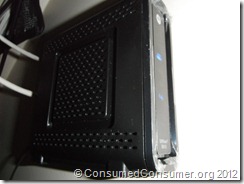 Essentially, the modem has a Gigabit Ethernet, a coaxial cable and a power adapter connection at its back. One of the sides is designed to allow it to hang on the wall while the other side as well as the top has an open mesh to allow ventilation. The front has 5 LEDs. The Power and Online (first and 4th from the top) should always be solid green. For the Receive and Send, green indicates non-bonded connection(s) while blue indicates bonded ~. The Link LED indicates activity on the Ethernet connection and it is blue if it’s a gigabit connection and green otherwise. I had previously thought that my router is not capable of Gigabit connection on the WAN port, but this blue LED proved me wrong, much to my satisfaction. Also, the blue download light suggests that my downlink is bonded, while the green uplink tells me it’s not. Otherwise, I should’ve moved the LAN port into the same VLAN as the WAN. The following might also apply:
Essentially, the modem has a Gigabit Ethernet, a coaxial cable and a power adapter connection at its back. One of the sides is designed to allow it to hang on the wall while the other side as well as the top has an open mesh to allow ventilation. The front has 5 LEDs. The Power and Online (first and 4th from the top) should always be solid green. For the Receive and Send, green indicates non-bonded connection(s) while blue indicates bonded ~. The Link LED indicates activity on the Ethernet connection and it is blue if it’s a gigabit connection and green otherwise. I had previously thought that my router is not capable of Gigabit connection on the WAN port, but this blue LED proved me wrong, much to my satisfaction. Also, the blue download light suggests that my downlink is bonded, while the green uplink tells me it’s not. Otherwise, I should’ve moved the LAN port into the same VLAN as the WAN. The following might also apply:
Note: Only VLAN's 0-15 are usable on 100mbit models and VLAN's 1-15 on gigabit models.
Second WAN port
You can move ports to the WAN VLAN to make them act as WAN ports residing outside the router's NAT or to just replace a damaged WAN port. Devices attached to these ports will request their IP addresses from the ISP instead of getting a private IP address from your router. One might want to have such behavior when having unsorted firewall issues with a SIP operator.
nvram set vlan0ports="1 2 3 5*" nvram set vlan1ports="0 4 5" nvram commit reboot
I then packed the old modem (together with the power supply) and purchased a mailing label from CanadaPost for
177 Nepean St, Suite 300
Ottawa, ON
K2P 0B4
The modem return cost me a total of $9.99, which added to the total cost of the new modem (including shipping), comes to a grand total of $100.03. Considering the monthly cost of modem rental and with no regard to interest rates I should break even after 18 months. The advantage of this modem rests however in greater ease of switching providers and the possibility of much higher speeds.
This is both an advantage and, as Admiral Ackbar might say, a trap, because now I’m invested in this technology and cannot so easily switch to ADSL or VDSL anymore (I could, but I’d have to write off this $100 investment). On the other hand, cable internet is generally faster than phone line internet in virtually any market, despite its lower customer satisfaction numbers. Other than Rogers, the cable regional monopoly in my area, I could also use Distributel/3web/CIA or Teksavvy or Acanac. Though they resell Rogers services, they manage to charge less than them.
signal
To see the line quality performance, first I wanted to check what the modem reports, so I went to http://192.168.100.1. No login / password was necessary (for some other Motorola cable modems it’s admin / motorola). The status page suggested that everything’s fine:
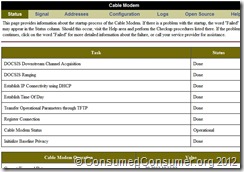 The signal page provided info on the quality of the signal provided by Rogers cable network:
The signal page provided info on the quality of the signal provided by Rogers cable network:
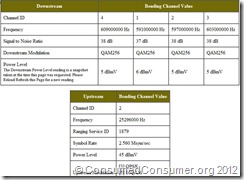 Here’s what the numbers mean (in brackets in italics, my value).
Here’s what the numbers mean (in brackets in italics, my value).
Downstream (Rx) Receive Power Level:
This is the amount of signal received by the modem from the transmitter in the cable company head-end.
For all modems:
-10 dBmV to +10 dBmV "Recommended". <—
-11 dBmV to -14 dBmv / +11 dBmV to +14 dBmV "Acceptable".
-15 dBmV & +15 dBmV "Maximum".
I’m getting 5-6 dBmV.SNR (signal to noise ratio) levels:
This is how clear the signal is at either the modem receiver (downstream SNR) or the receiver in the cable company head-end (upstream SNR).
DOCSIS specifications list minimum CNR (carrier to noise ratio) levels not SNR levels. The SNR levels listed here are based on commonly recommended MER levels for digital cable signals. Not all QAM demodulator chipsets accurately calculate SNR levels that approximate actual MER levels, so these levels may vary depending on which chipset and/or firmware is used in the equipment.
QPSK: 12 dB minimum. 15 dB or higher recommended. (often used in upstream channels)
16 QAM: 18 dB minimum. 21 dB or higher recommended. (often used in upstream channels)
64 QAM: 24 dB minimum. 27 dB or higher recommended. (often used in downstream channels)
256 QAM: 30 dB minimum. 33 dB or higher recommended. (often used in downstream channels) <--
*There is no upper SNR limit; however, 40 dB is the highest most people see. Going above 40 dB is possible though.
I’m getting 37-38 dB on 256 QAM downstream.Upstream (Tx) Transmit Power (a.k.a. Return Signal) level:
This is the amount of signal transmitted by the modem to reach the receiver in the cable company head-end.
+8 dBmV to +58 dBmV maximum for QPSK. (DOCSIS 1.0, 1.1) <--
+8 dBmV to +55 dBmV maximum for 8 QAM and 16 QAM. (DOCSIS 1.0, 1.1) <--
+8 dBmV to +54 dBmV maximum for 32 QAM and 64 QAM. (A-TDMA DOCSIS 2.0)
+8 dBmV to +53 dBmV maximum for S-CDMA DOCSIS 2.0 (All Modulations)
*Recommended upstream signal levels are +35 dBmV to +52 dBmV.
My 45 dBmV upstream signal level falls within the recommended range.
 Not too many errors either.. Here’s more info from the FAQ (linked below in sources):
Not too many errors either.. Here’s more info from the FAQ (linked below in sources):
A house or drop amplifier will NOT fix an upstream signal problem because most house amplifiers don't amplify the upstream signals; they only pass the upstream signal through with some loss.
Important notes concerning signal levels:
1. Signal levels not within the specifications listed above can cause slow speeds, connection problems, and connection loss due to packet errors, packet loss, and/or constant packet retransmission.
2. It's recommended to have the modem's signal levels at least 3dB away from the maximum/minimum levels listed above due to normal temperature related signal variation. If the modem's signal levels are at the maximum or minimum limits, they may be out of spec. if the temperature changes significantly. Signal levels that vary more then 3 dB in a 24-hour period usually indicate a problem that should be looked into.
3. Excess splits, bad connectors, and/or poor quality cabling will certainly effect cable signal levels and will cause problems.
Finally, the Help page contains info re: firmware:
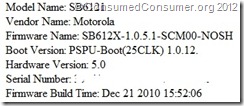 It seems that the modem runs on 1.0.5.1 firmware, while online reports suggest that there are modems running on 1.0.6.1 or newer already. Unfortunately, the firmware is not user upgradeable. It’s up to Rogers to push new firmware.
It seems that the modem runs on 1.0.5.1 firmware, while online reports suggest that there are modems running on 1.0.6.1 or newer already. Unfortunately, the firmware is not user upgradeable. It’s up to Rogers to push new firmware.
The problem I’m having is that the speed seems to have dropped. More precisely, with the previous SB5100 modem, the upload speed was around 0.51 Mbps while the download speed was around 30 (and as high as 40) Mbps. Speedtest.net using various servers in the vicinity has shown a speed around 20 Mbps for download and 0.48 Mbps for upload. Further investigation early in the morning, when connections are fast, should answer the following questions:
- Would the speed vary with different IPs?
- Would enabling / disabling QoS on the router and rebooting make a difference? What about other apparently unrelated router customizations?
Upgrading the modem, as many other user reports have pointed out, is not always such a great investment. Much like the upgrade from 32bit to 64bit computing did not result in immediate performance increases but rather only in stability and the potential for future improvements, so did the upgrade to the DOCSIS 3.0 modem result in slightly lower speeds coupled with more resilience and less variation in speed throughout the day or location of the test servers. Downloads and uploads are slightly slower under my current tiered speed cap, but they are more “solid”, resilient and predictable.
Sources / More info: dslr-comcast-modems, dslr-signal, pcw-troubleshoot, ddwrt-wan
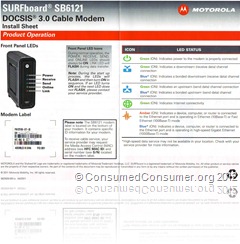

Comments